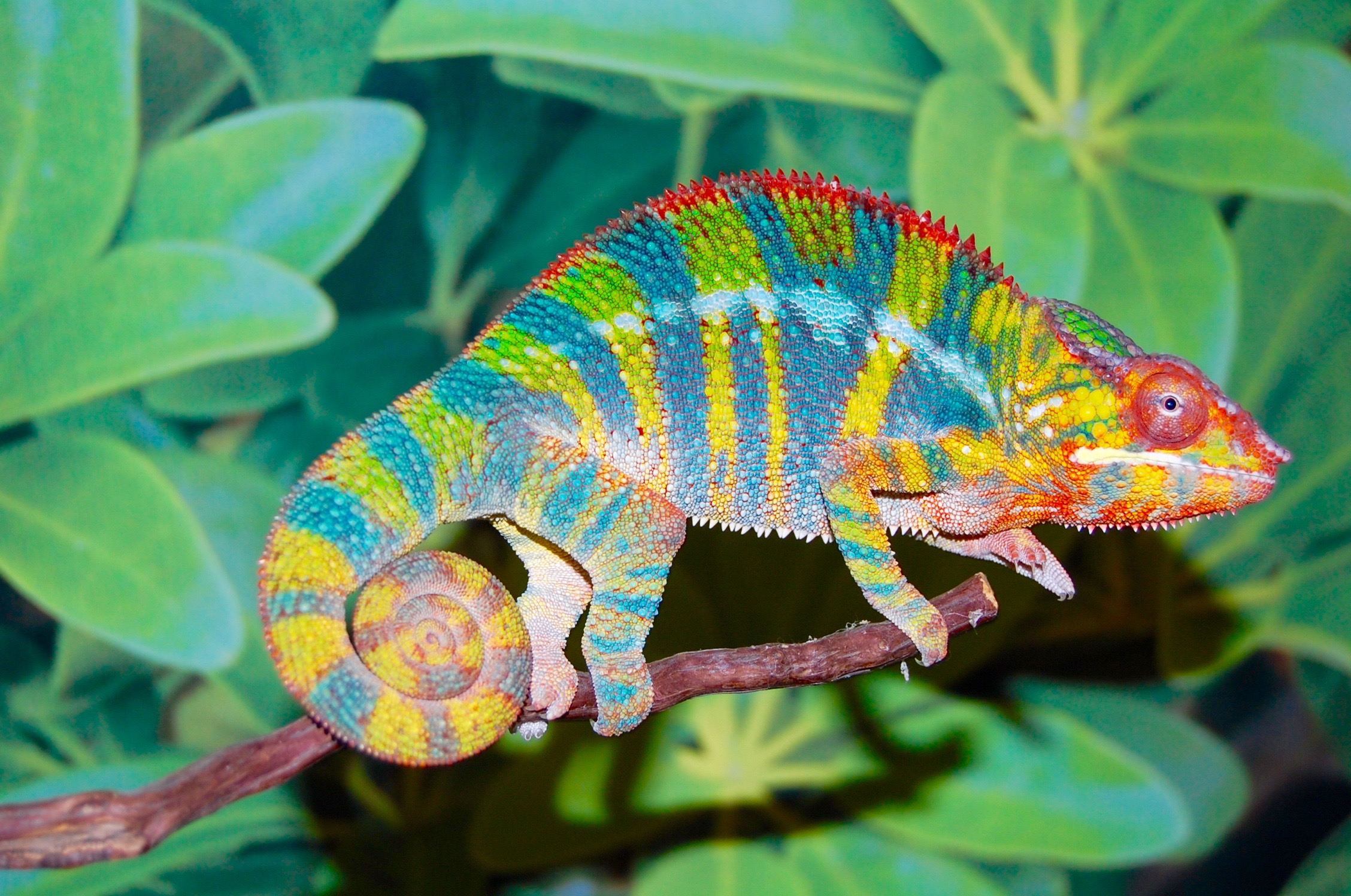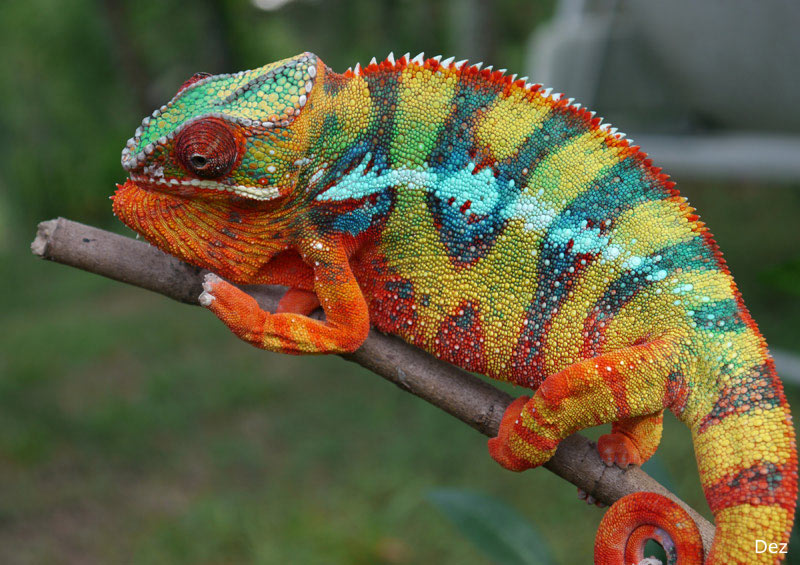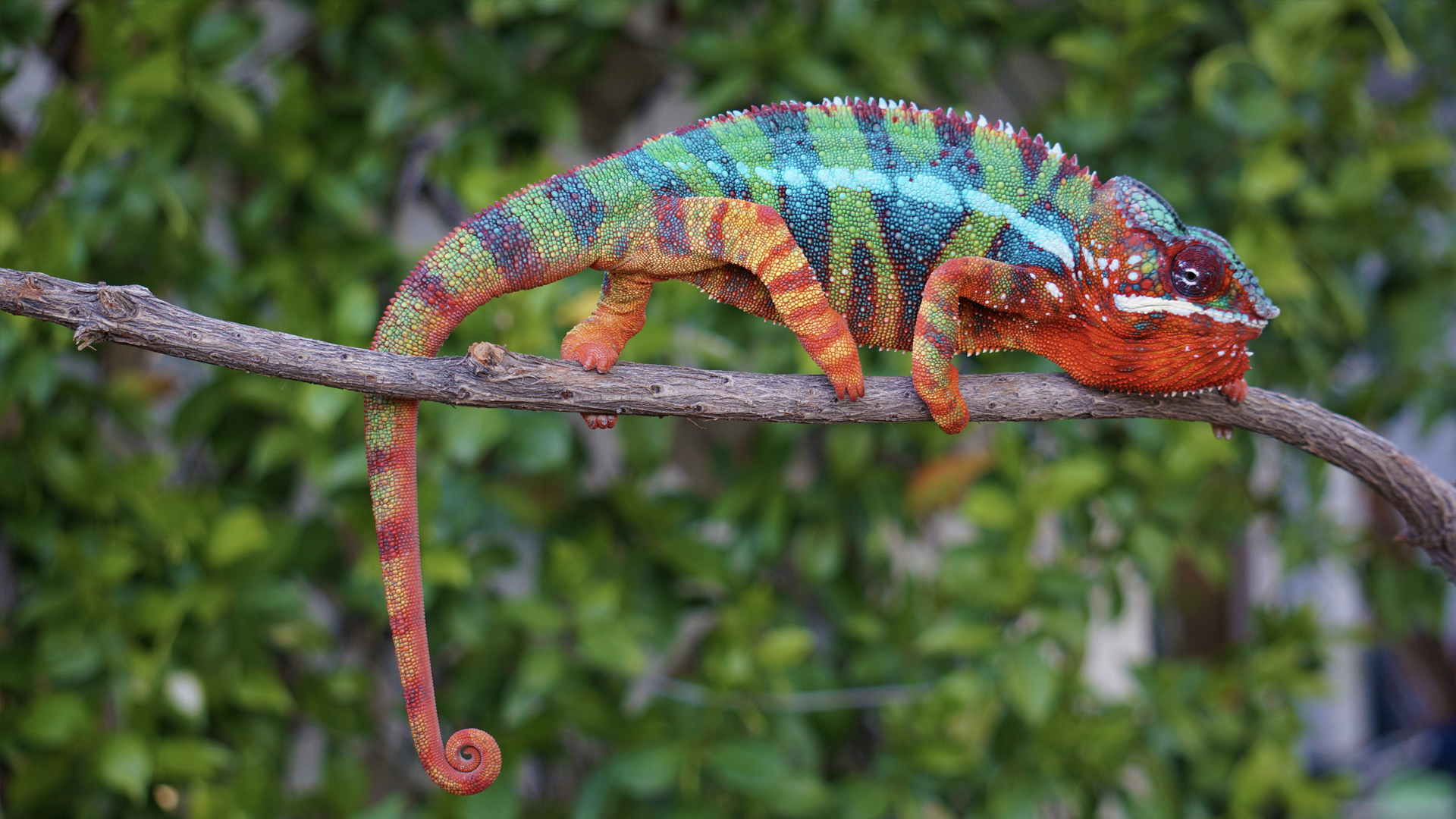Panther Chameleon - A Guide To Their Wonderful World
Considering a new companion that brings a splash of living color into your home? The panther chameleon, a creature known for its truly amazing appearance, often captures the eye of many animal lovers. They are, you know, very popular for a really good reason, and it's mostly about how incredibly varied their patterns of color can be. People are drawn to these animals because of their stunning looks, which seem to shift and change in a way that is, well, just captivating to watch.
For anyone thinking about welcoming one of these fascinating reptiles into their life, there's quite a bit to consider, actually. From understanding their unique needs to simply enjoying their presence, it’s a whole adventure. Some folks, for instance, have had a female panther chameleon for about eight months, getting to know her quirks and daily habits, which is, in some respects, a really rewarding experience. Others might have a male, perhaps three years old, and they’ve seen him through different stages of his life, which can bring its own set of things to think about, like keeping them comfortable and healthy.
Whether you're new to keeping these sorts of animals or have had others before, like maybe a bearded dragon or even a veiled chameleon, the panther chameleon does present its own particular set of things to learn. It’s not just about getting one; it's also about setting up their home just right, understanding their behavior, and knowing what to do if they seem a little off. This guide will, more or less, walk you through some common questions and observations people have shared about these striking creatures, helping you feel a bit more prepared for what's involved.
Table of Contents
- What Makes a Panther Chameleon So Special?
- Setting Up a Home for Your Panther Chameleon
- Are There Health Concerns for a Panther Chameleon?
- The Cost of a Panther Chameleon
- Thinking About a Panther Chameleon Egg?
- Choosing the Right Panther Chameleon Cage Setup
- Do Panther Chameleons Have Peculiar Eye Movements or Shedding Habits?
- Considering the History of Panther Chameleon Colors
What Makes a Panther Chameleon So Special?
One of the biggest draws to a panther chameleon is, without a doubt, their incredible range of colors. It’s actually what makes them stand out, perhaps more than anything else. You see, their color patterns are incredibly diverse, and that’s a primary reason why they are so sought after by people who appreciate unique pets. It’s not just one shade, or even a few; it’s a whole spectrum of possibilities, which means each animal can look quite distinct. This variety is, you know, part of their charm, making every individual chameleon a little bit of a living piece of art.
This wide array of colors isn't just for show, either. It’s part of how they interact with their surroundings and express themselves. For instance, a male panther chameleon, maybe one that’s three years old, might display different hues depending on his mood or what he’s trying to communicate. It's a rather fascinating aspect of their being. People who have had them for a while, like those who’ve kept a female panther chameleon for eight months, often speak about how captivating it is to observe these changes. It’s a dynamic beauty, you see, that keeps things interesting and provides a constant source of wonder for their human companions.
When you consider getting one, this characteristic is usually at the top of the list of reasons why someone is interested. It’s that visual appeal, the sheer beauty of their appearance, that really grabs attention. And, in a way, it’s a good starting point for learning about them, because their colors are so tied into their overall well-being and behavior. You might find yourself, basically, just watching them for long stretches, trying to catch every subtle shift in their skin tone. It’s a pretty unique experience, truly.
Setting Up a Home for Your Panther Chameleon
Getting the living space just right for a panther chameleon is, in fact, one of the most important steps. It’s not just about picking a cage; it’s about creating an environment that feels natural and supports their health. For example, some people who have a few of these creatures, maybe two or three panther chameleons, make sure they all have what they need. This often includes sharing a good light source, like a four-foot fluorescent light that provides a full spectrum of light, which is pretty essential for their well-being, you know. Each one also needs its own space, even if they share some equipment.
The lighting setup is, in some respects, a really big deal for a panther chameleon. They need specific types of light to help them stay healthy and process important nutrients. A full spectrum light, like the fluorescent one mentioned, tries to mimic the sun's rays, which is what they would naturally get in their native homes. This attention to detail in their living quarters is, arguably, what makes a big difference in how well they thrive. It’s about more than just light; it's about warmth and the right kind of rays for their bones and overall system.
Beyond the lights, there are other aspects to consider for their habitat. You want to make sure they have plenty of places to climb and hide, which helps them feel secure and gives them opportunities for exercise. It's about creating a little world for them inside their enclosure. Someone who is, say, thinking about getting a panther chameleon they’ve had their eye on, often finds themselves a bit unsure about all the cage setup options out there. It really does seem like there are so many choices, and figuring out the best one can feel a little overwhelming at first, but it’s a necessary step for their comfort.
Are There Health Concerns for a Panther Chameleon?
Just like any living creature, a panther chameleon can, at times, face health challenges, and it's something good owners keep an eye on. For instance, there was a male panther chameleon, three years old, who started struggling with a weakness in his grip. This is, you know, something that can be a sign that something isn't quite right. When something like that happens, it’s usually a good idea to seek help from a professional who knows about these kinds of animals.
Taking your panther chameleon to the vet is, in fact, a very sensible step if you notice any changes in their behavior or physical condition. In the case of the chameleon with the weak grip, the vet performed blood work. This kind of testing helps to figure out what might be going on inside, providing a clearer picture of their health. While the exact outcome of that visit isn't detailed, the fact that a vet was involved and blood work was done shows that owners are often very committed to getting their pets the care they need, which is really important.
Being aware of common signs of trouble, like a weak grip or changes in eating habits, is, you know, pretty helpful for anyone who has a panther chameleon. It allows you to act quickly if something seems amiss. Even if you're relatively new to keeping these animals, perhaps having had veiled chameleons before, learning about the specific needs and potential health issues of a panther chameleon is a really valuable thing to do. It’s about being prepared for whatever might come up, ensuring your animal stays as healthy and comfortable as possible for as long as possible.
The Cost of a Panther Chameleon
When you’re thinking about bringing a panther chameleon into your life, the cost is, in fact, a factor that often comes up. These animals can vary quite a bit in price, depending on several things. For example, some of the highest priced panther chameleons that have been listed can go for as much as $1200. This kind of price point is, basically, about the most you would expect to pay for a sub-adult male panther chameleon that has been raised in captivity, individually, and shows truly amazing qualities. It's a pretty significant investment, to be honest.
The price tag often reflects the effort put into raising the animal and its specific characteristics. A panther chameleon that is captive-bred means it was born and raised in a controlled environment, which can contribute to its health and temperament. Individually raised means it received specific attention, which is, you know, often a good sign of quality care. And when they say "amazing" qualities, they're often talking about their vibrant colors and overall appearance, which, as we've discussed, is a big part of their appeal. So, the cost is, in a way, tied to the quality and the care that went into the animal before it finds its new home.
It’s important to remember that the initial purchase price is just one part of the financial picture. There are also ongoing costs for their habitat, food, and potential vet visits, as we talked about. So, while a $1200 panther chameleon might seem like a lot, it’s usually for a very particular kind of animal, and it sets the upper limit for what you might expect to pay. Most people will find options that are, you know, less expensive but still healthy and beautiful, which is good to keep in mind when you’re budgeting for a new pet.
Thinking About a Panther Chameleon Egg?
For those who are, perhaps, looking for a truly unique experience, raising a panther chameleon from an egg can be an option. There are people who become first-time chameleon owners specifically because they want to go through the process of egg hatching. It’s a different kind of beginning than buying a sub-adult, you know, and it comes with its own set of things to learn. Some individuals have purchased a chameleon egg from an online breeder a few months back, waiting for that estimated hatch time, which can be a period filled with anticipation.
Getting an egg, rather than a hatched animal, means you’re involved from the very start of its life. This can be, in some respects, a really rewarding endeavor, but it also requires specific knowledge about incubation and care for very tiny hatchlings. It's not something to jump into without a little bit of preparation, basically. The online breeder usually provides an estimated hatch time, which helps you get ready for the arrival of your very small panther chameleon. It's a commitment that starts even before the animal is visible, truly.
For someone new to keeping chameleons, seeking advice on egg hatching is a very sensible thing to do. There's a lot to learn about maintaining the right conditions for the egg to develop properly and then caring for the delicate creature that emerges. It’s a more involved process than bringing home an already established animal, but it offers a chance to witness the entire life cycle from the very beginning. So, if you're considering this path for your panther chameleon, definitely look for guidance and prepare for the unique journey ahead.
Choosing the Right Panther Chameleon Cage Setup
Deciding on the perfect living space for a panther chameleon can, honestly, feel a bit overwhelming because there are just so many choices out there. Someone might have a truly beautiful panther chameleon in mind that they've been wanting to get, but they find themselves really unsure about the whole cage setup. It seems like there's an endless array of options, which, while offering flexibility, can also make the decision-making process a little tricky, you know.
The right cage setup isn't just about size; it's also about the materials, the ventilation, and how it allows you to create the proper environment inside. For example, you need to think about where the lights will go, how to maintain the right temperature and humidity, and how to provide climbing structures. These are all pretty important aspects for the well-being of your panther chameleon. It’s about creating a space that mimics their natural habitat as closely as possible, which helps them feel secure and encourages natural behaviors.
For those who are relatively new to keeping chameleons, perhaps having had bearded dragons or even veiled chameleons before, understanding the specific needs of a panther chameleon's enclosure is crucial. While you might have experience with other reptiles, each species has its own particular requirements. So, if you’re curious about the "right" setup, it usually involves looking into specific recommendations for panther chameleons, which can differ from what other reptiles need. It's a bit of a learning curve, but one that ensures your animal has a comfortable and healthy home, which is, basically, what every good owner wants.
Do Panther Chameleons Have Peculiar Eye Movements or Shedding Habits?
People often wonder about some of the more unique behaviors of a panther chameleon, especially concerning their eyes and how they shed their skin. For instance, a common question is, "Do they do anything weird with eyes?" And the answer is, in fact, they do have very unique eye movements. Their eyes can move independently, which means one eye can look forward while the other looks backward, which is, you know, pretty amazing for spotting things around them. It’s a remarkable adaptation that allows them to scan their surroundings without moving their head, which is, basically, a great way to stay aware of their environment.
Another common question relates to shedding: "Does it come off in one piece like a snake?" Unlike snakes, which typically shed their skin all in one go, a panther chameleon sheds in patches. So, you won't see a whole, intact skin left behind. Instead, you'll notice bits and pieces of skin flaking off over time. This is, in some respects, a normal process for them as they grow. Knowing what to look for during shedding, like seeing these small pieces come off, helps you understand if your panther chameleon is healthy and growing as they should. It’s just one of those things that makes them a little different from other reptiles, truly.
Understanding these natural behaviors, like their independent eye movement and their patch-shedding, is part of getting to know your panther chameleon. It helps you recognize what's normal for them and what might be a sign of something unusual. If you're wondering, "What can I look for?" in terms of shedding, just observe if the skin is coming off in small, flaky bits, and that’s usually a good sign that things are proceeding as they should. It’s all part of the fascinating experience of having one of these creatures as a companion, you know.
Considering the History of Panther Chameleon Colors
The incredible color variations of the panther chameleon are, without a doubt, one of their most striking features, and it’s something many people feel strongly about preserving. There's a concern, for some, about what happens to the history of these incredible color variations, especially if certain breeding practices are used. It just doesn't feel right to some people if these distinct patterns and hues, which are tied to specific locations or "locales," get mixed up. This is, you know, a pretty passionate topic among enthusiasts and breeders.
The idea is that each locale, or geographical area where a panther chameleon originates, tends to have its own characteristic color scheme. Preserving these distinct lines is important to many because it maintains the natural diversity and beauty of the species as it exists in different parts of the world. However, other breeders may totally disagree with this viewpoint and might crossbreed different locales. This can lead to new color combinations, but it also, in a way, blurs the lines of their natural history and distinct origins. It’s a debate within the community, basically, about how to best manage these amazing animals.
For someone interested in a panther chameleon, being aware of this discussion about color history and breeding practices can be quite informative. It helps you understand why some animals are valued for their "pure" locale colors, while others might offer a mix of traits. It's about appreciating the natural artistry of these creatures and, you know, thinking about how we can best ensure their unique characteristics continue to be celebrated and understood. It’s a testament to how much people care about these animals and their amazing appearances.
This article has touched upon the captivating beauty of the panther chameleon, especially their varied color patterns, which make them so popular. We looked at personal experiences with these animals, from caring for a female for eight months to managing multiple chameleons under shared lighting. The discussion also covered the financial aspect, noting that a top-tier, individually raised male can reach $1200, and highlighted the importance of proper cage setup, which can be a bit of a puzzle for new owners. Health concerns, like a male's grip weakness leading to a vet visit and blood work, were mentioned, emphasizing the need for attentive care. The piece also briefly explored the unique journey of hatching a chameleon egg and the common questions about their peculiar eye movements and how they shed their skin. Finally, it touched on the community's thoughts about preserving the history of their incredible color variations, reflecting different approaches to breeding.

Panther Chameleon Habitat

Panther Chameleon Habitat

A Story of Panther Chameleons: Their Care, Husbandry, and Breeding